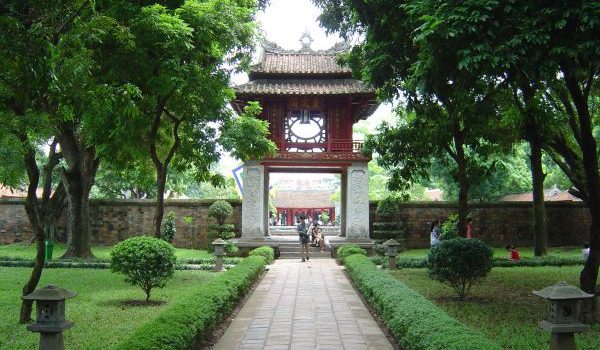ALL ABOUT TEMPLE OF LITERATURE

Temple of Literature is one of Things to do in Hanoi, a must-see historical site when visiting Hanoi, the Capital City of Vietnam.
Temple of Literature not only represents the enduring progress of Vietnamese culture( sự thay đổi Văn Hóa Việt Nam theo thời kỳ) , but also contributes significantly to both Confucian civilization (Đạo Khổng Tử) in Vietnam and other cultures in the world.
- Temple of Literature was ranked as the cultural and historical site on 28th April, 1962.
I. Temple of Literature In Hanoi
I.1 Temple of Literature Hanoi introduction
How did Temple of Literature appear?
The Temple of Literature was built in 1070 during Ly dynasty to honor Confucius (Confucius was a Chinese teacher, Politician, Philosopher and Founder of Confucianism)
Confucianism
According to his philosophy, Confucianism, people must obey five relationships in the society:
- Ruler and Subject.
- Father and Son
- Elder Brother and Younger Brother
- Husband and Wife
- Friend and Friend
Imperial Academy
In 1076, Vietnam’s first university, the “Quoc Tu Giam” or Imperial Academy, was established by King Lý Nhân Tông. The Imperial Academy originally reserved only for sons of the Kings and madarins. Finally, it was opened for all talented students.
General structure of Temple of literature
Temple of literature complex encompasses five walled courtyards connected by gateways. The number of courtyards, five, is the symbolic number of five basic elements forming the world:
- Five basic elements: Metal – Wood – Fire – Water – The earth.
Phoenix and dragon symbols are used to represent the Empress and Emperor:
- A phoenix represents beauty – A dragon represents power.
The below is structure of 5 main parts of Temple of Literature Hanoi
I.2 The First Courtyard- Đại Trung Môn (The great middle gate)

The first courtyard extends from Đại Trung Môn (The Great Middle Gate) to the Đại Trung area.
Đại Trung Môn (The great middle gate) is a combination of the names of two great books of Confucianism:
- Đại Học ( Great learning)
- Trung Dung ( The Doctrine of the Mean)
Two smaller gates on the left and right side of Đại Trung Môn
- Accomplished Virtue (Thành Đức)
- Attained Talent (Đạt Tài)
In ancient Orient concept, left side is more important than right (From Confucius point of view). Therefore, Virtue is more important than Talent.
The carp symbol located at the top of the gate has a meaningful story due to Chinese legendary: “Many carps swim upstream against the river’s strong current in a contest held by God, but only few are capable of the final leap over the waterfall. If a carp successfully makes the jump, it can transform into a powerful dragon.”
- The carp overcoming waterfall: hardships that students must overcome if they want to get success in education
- The carp becoming dragon: student’s promotion in social rank
Plus,
In the past, students had to pass three exams to become government official: Regional exam (Hương examination), National exam (Hội examination) and Royal exam (Đình examination).
Firstly, those students passing the Regional exam (Hương Examination) would be named at the academy.
- During the course at the academy, the students discussed literature, wrote poetry and learned about Chinese philosophy and culture. The students were enrolled for three to seven years. They had minor tests each month and four major tests each year.
After succeeded in the exams during the course, the students were awarded certification by the Ministry of Rites, qualified them to sit for the National exam (Hội examination)
Finally, after qualifying from National Exam (Hội examination) enables students to take the Royal Exam (Đình Examination), held at court.
In case the students failed the exam, they have to wait for three more years for the next exam.
I.3 The Second Courtyard- Khuê Văn Các (The Pavilion of Constellation)

Located in the Second Courtyard is Khue Van Pavilion (Pavilion of Constellation)
- A unique architectural work was built in 1805 under Nguyễn Dynasty- regarded as the symbol of Hanoi in the present time.
- Given the meaning of term ‘Constellation’ as the brightest star – that carry the wish for development and prosperity for education and culture of Vietnam.
On top of the pavilion is the combination of the circle and the square:
- The circle represents the sky
- The square represents the earth.
This is the symbol of the yin and yang harmony.
I.4 The Third Courtyard – Thien Quang well and Doctor Stelae
Thien Quang Well
In the center of the third courtyard is Thien Quang well (Well of Heavenly Clarity). Some functions of Thien Quang Well are:
- To keep the atmosphere of Văn Miếu complex to be tranquil
- To purify people’s mind
- Being as a mirror for people to arranging their dress before entering the most scared part of the complex

Doctor Steles
A general Doctor Stele includes 3 parts:
- The first part wrote nice words toward the Emperor, his royal court and Confucianism
- The second part commented on the importance of building steles and the responsibility of successful people toward the country
- The third part was information about the exams and successful students
Originally, there are 91 doctorate steles.
However due to wars and natural disaster, there are only 82 left.
In putting the steles on the back of the tortoises:
- The tortoises stand for longevity and wisdom so the names of successful students would last forever

I.5 The Fourth Courtyard- Đại Thành Môn (The gate to great success), and Đại Bái Đường (House of Ceremony)
Leading to the Fourth Courtyard of the temple is Đại Thành Môn (The Gate to the Great Success)

In the center of the fourth courtyard is the Đại Bái Đường (House of Ceremony)
- The house of ceremony is a place for Emperors and Fellows to make their offerings to Confucius. New doctors come to House of Ceremony to kneel and bow to show their respect

In Đại Bái Đường, the pair of crane and turtle that present desire of longevity and eternity

On each side of the fourth courtyard stands two areas. The original purpose was to keep altar Confucius and Chu Văn An (a master of the Imperial Academy), yet they have now been converted into souvenir shops and drinks stalls.Adjacent to house of ceremony is Đại Thành Sanctuary where Confucius and his four greatest disciples are worshipped.
In the present day, the locals come to Đại Thành Sanctuary to pray for blessings with incense and offerings.

I.6 The Fifth Courtyard, grounds of the Imperial Academy

The Fifth Courtyard has been through long history.
- In 1076, Emperor Ly Nhan Tong ordered the construction of an imperial academy as a fifth courtyard
- In 1946, the courtyard was destroyed by the French.
- In 2000, it was reconstructed on the ground of the original “Imperial Academy” as a temple.
The upper floor is dedicated to the three emperors who contributed mostly to the foundation of the temple and the academy:
- Ly Thanh Tong (1023–1072), who founded the temple in 1070 (In the middle of altar)
- Ly Nhan Tong (1066–1127), who founded the Imperial Academy (On the right altar)
- Le Thanh Tong (1442–1497), who ordered the built of doctor statues in 1484 (on the left altar)
Around the Fifth Courtyard, some buildings hold a drum and a bronze bell. The drum is 2.01 metres wide, 2.65 metres high, has a volume of 10 m3 and weighs 700 kilograms. The bell was cast in 2000. It has a height of 2.1 metres and it is 0.99 meters wide.

II. Temple of Literature opening hours, price, dress code, map
II.1 Temple of Literature opening hours
Opening days: Monday, Tuesday, Wednesday, Thursday, Friday and Sunday
Opening time:
- In summer ( From April to October) : 07:30-17:30
- In winter (From October to April) : 08:00-17:00
II.2 Entrance fee
Entrance ticket price (2017):
- Adult: 30,000 VND (~US$ 1.3) for Vietnamese and foreigners
- Students: 15,000 VND (~US$ 0.7) (ID, students card required)
- Children under 15: Free
II.3 Dress code
As Temple of Literature is a formal historical site, visitors should pay serious attention to the dress code as visitors need to be respectable.
In detail, no hat, shorts, mini skirt or tank-top…when being in worshipping/sanctuary area.
II.4 Map

Note:
5-6: The first courtyard
7: The second courtyard
8-9: The second courtyard
10-11: The fourth courtyard
12-13-14-15: The fifth courtyard
III. Free tour in Temple of Literature Hanoi
Visitors are highly recommended to book a free tour in Hanoi. Hanoi Free Local Tours are organized by groups of young passionate students, who are well-trained to have full knowledge about attractions in Hanoi and tour guide skills. Booking a tour is easy as visitors only have to go to websites and fill in a tour’s order. Visitors will receive a confirmation from tour director and they will be picked at their hotel or arranged meeting place at time as appointed.
Author: Kristen Nguyễn
For more information/details: Halong Bay Cruises – Hanoi Tour – Vietnam Tours – Sapa Tours – Package Tours or book a private car to discover where ever you want to enjoy the Vietnamese taste.





